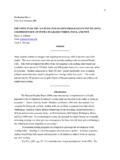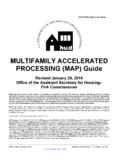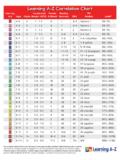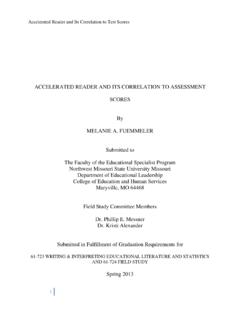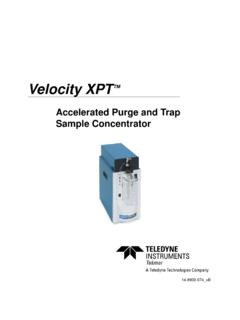Transcription of Accelerated Low Water Corrosion - ae-sys.com
1 Accelerated Low Water CorrosionAlthough Corrosion is usually a predictable and manageable phenomenon, it is now evident that certainconditions in the marine environment lead to Corrosion rates far in excess of normal. Left unchecked, thiscan ultimately lead to primary and secondary structural deterioration, significant costs and increased safetyrisks. A typical Corrosion rate for steel in a marine environment could be regarded as to peryear. However, in cases of Accelerated Corrosion , rates of 1mm per year or even higher have been reported,clearly anything that will eat through a 5mm plate in 5 years has to be taken commonly referred to as Accelerated Low Water Corrosion , ALWC can occur in areasaway from the low Water band and be caused by different individual or combinations of corrosionmechanism and may also be referred to simply as Accelerated or Concentrated Corrosion as well asMicrobially influenced Corrosion (MIC).
2 The first signs of Accelerated Corrosion on amarine structure may also be the last. Once thesurface behind a quay has subsided, for example,and hundreds of cubic metres of backfill have beendeposited through large holes in the quay wall, theresulting structural instability and reducednavigable depth of the quayside would mean totalreconstruction of the quay or even total : holes on pilesIt is clear that the sooner ALWC is detected and addressed the less expensive will be the remedial intervention makes economic main obstacle to detecting Accelerated Corrosion , however, is the fact that most incidents occur ator below the low- Water line and are therefore not readily seen.
3 Furthermore the telltale signs, be they aboveor below the Water line, can be covered and visually hidden by years of accumulation of marine a first stage in managing this problem the following has to be addressed:!What are the Corrosion mechanisms?!What is the significance of Accelerated Corrosion attack?!What does Accelerated Corrosion look like?!How can it be detected, preferably in the early stages?The second stage, which we will come to later, deals with both prevention and cure of ALWCCORROSION MECHANISMSMICM icrobially Induced Corrosion is that in which the actions of micro-organisms generate conditions that startcorrosion. 10% of all Corrosion cases involve MIC and the majority of Accelerated low Water Corrosion casesare caused by the action of the sulphate-reducing bacteria (SRB) organism in particular.
4 Normally, structuralsteel, in the absence of crevices or galvanic effects, tends to corrode over its entire surface. The rate ofcorrosion is controlled by the rate at which dissolved oxygen reaches the metal surface. Biological organismshave the potential to increase or decrease oxygen transport to the surface; consequently increasing or decreasinggeneral Corrosion . Most MIC, however, manifests as localised Corrosion because microscopic organisms tendto settle on metal surfaces in the form of discrete colonies rather than continuous organisms fall under two groups based on the type of Corrosion they cause: Anaerobiccorrosion and aerobic Corrosion .
5 Sulphate reducing bacteria (SRB) are anaerobic, they form corrosivesulphide by reducing sulphate. SRBs consume hydrogen and depolarise the cathode, thereby acceleratingcorrosion. Aerobic sulphur oxidizing bacteria can create an environment of up to 10 percent sulphuric acid,thereby encouraging rapid of bacteria produce sticky polymers which attract other species to colonisation sites. This,in addition to the metabolism of available oxygen, iron, manganese, etc., leads to the formation of crevicesas well as oxygen and ion concentration cells, accelerating the Corrosion process. Because most bacteriaremain fixed to the colonisation site, they create a condition underneath which causes the anodic site tobecome fixed, leading to pitting.
6 This is why more than 90% of MIC is seen as pitting-type also produce short-chain fatty acids (acetic acid being the most common) that are veryaggressive, especially to carbon steel, when concentrated under a colony or other mechanisms influencing ALWC may include:!Microcellular Corrosion : where electric cells set up between different areas of metal on the structure,usually steel, causing one area not to corrode at the expense of increased Corrosion at the other.!Stray current: similar to micro-cellular but Corrosion is induced by the presence of some electricalinstallation in the vicinity an electric travelling dockside crane.!Erosion: although strictly not a Corrosion mechanism the periodic dynamic removal of corrosionsurface deposits, by vessel rubbing, propeller wash, tidal or other currents, can increase the corrosionrate due to faster regeneration of research the full nature of these Corrosion mechanisms as well as their influences are still not fullyunderstood but the fact that Accelerated Corrosion , by whatever means, does occur on steel-piled marinestructures is now well documented and unquestionably SIGNIFICANCE OF THE ATTACKA ccelerated Corrosion is usually associated with sheet-pile walls ( Accelerated low Water Corrosion )
7 ,particularly at a level at or just below static (non-tidal) or low Water level in tidal areas. However, there areinstances of it occurring on hollow section and H-piles down to bed level, and on any other unprotectedsteel components in a susceptible : Northern Territory Department of Transport and Works Report, 13/9/ engineering report, investigating the collapse of a Northern Territory bridge, found that two piles of theAdelaide River Bridge were completely corroded through the base. This was caused by a number of factors,including a sulphate reducing bacteria which had attacked the steel and which had not previously been knownto exist in tropical Knight Merz, commissioned to investigate the collapse, reported five contributing causes forthe Corrosion of steel Reducing Bacteria: Extensive colonies with mushroom-like heads were found on the piles,particularly on bare steel sections.
8 The bacteria produced a sulphide slime, which attacked the steeland resulted in large pit Mud: A significant removal ofmud from the bridge site had occurredover 30 years, exposing then produced a weaksulphuric acid, which attacked the : Water velocity reaching per second continuouslyremoved Corrosion as it action within piles: Frictionbetween weld metal and parent action between pile groups: Corrosion in electrolyte where coatingshave degraded from : Diagram of bridge failureThe Adelaide River Bridge was constructed in 1966/67 as a one-lane bridge, although all the sub-structureto support two lanes was designed and built at the same time.
9 The bridge was upgraded to two lanes in1972/73. The bridge consists of a super structure of a concrete deck sitting atop three steel beams in turn sit on nine piers spaced at intervals of about across the river. Each piercontains five piles, a straight pile in the centre with two raker piles on each side. These piles consistof 16mm thick octagonal steel, some filled with concrete to varying levels as demanded in the are coated with coal tar maintenance included inspection and painting of the piles above the low tide mark, where anycorrosion was expected to occur, due to contact with oxygen and salt Water . Gradual erosion of the piersbelow the Water line was accounted for in the bridge design.
10 The expected loss in a tropical corrosiveatmosphere was 8mm per 100 years, providing a lifespan of over 100 years for the bridge. The fact that thelife of the affected piles was reduced by 75% may not be entirely attributable to the Sulphate ReducingBacteria, but it was clearly a significant factor. It is ironic that the inspection regime took into account theeffects of Corrosion but had expected the majority to occur above the Water piles are designed tohold things up, hold things back, or do both. The ability of each pile to do this is directly related to thethickness of steel and its shape. Any reduction of thickness results in a loss of strength. If enough steel islost at any particular location, say 50%; the ability of the affected pile to work as designed becomes practical outcome of this could involve placing restrictions on use.

